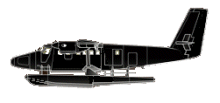
| Date: | Sunday 30 September 1979 |
| Time: | 13:00 |
| Type: |  de Havilland Canada DHC-6 Twin Otter 200 |
| Owner/operator: | West Coast Air |
| Registration: | C-FWAF |
| MSN: | 122 |
| Year of manufacture: | 1968 |
| Total airframe hrs: | 13815 hours |
| Engine model: | Pratt & Whitney Canada PT6A-20 |
| Fatalities: | Fatalities: 2 / Occupants: 16 |
| Aircraft damage: | Substantial, written off |
| Category: | Accident |
| Location: | Porpoise Bay, BC -
 Canada Canada
|
| Phase: | Approach |
| Nature: | Passenger - Scheduled |
| Departure airport: | Vancouver-Coal Harbour SPB, BC (CXH/CYHC) |
| Sechelt Airport, BC (YHS) | |
| Confidence Rating: |
A float-equipped de Havilland Canada DHC-6 Twin Otter passenger plane was damaged beyond repair in an accident at Porpoise Bay, BC, Canada. Of the two crew and 14 passengers on board, the captain died on impact and the first officer received serious injuries. One passenger died later as a result of injuries. Three passengers
received serious injuries and 10 passengers received minor/no injuries.
Flight 106 departed Vancouver Harbour at 12:35 on a domestic flight to Sechelt Airport, BC (YHS) at Porpoise Bay and Powell River. The flight was uneventful until it neared Sechelt. As the aircraft passed over the southern shoreline of Porpoise Bay at about 200 ft. it began to roll to the right. The angle of bank increased to about 90 degrees, with the nose dropping. The aircraft descended and struck the ground in a right wing-down nose-low attitude on the eastern shore of the bay 165 ft from the water.
Initial impact was with the right wing, followed by the right float and the nose of the aircraft. It then cartwheeled and came to rest against trees facing about 110 degrees to the right of the final direction of flight.
PROBABLE CAUSE: The right-hand aileron bellcrank-to-aileron rod had separated from the bellcrank end fitting due to an extensive stress corrosion crack. This allowed the right-hand aileron to move up, causing asymmetric lift and irretrievable loss of control. The specified visual inspection of the rods was inadequate to detect stress corrosion cracking. Previous similar failures of flap rods on the DHC-6 had led to airworthiness action by the manufacturer and the DOT but these measures were not applied to the aileron rods which are of similar construction.
Sources:
CASB Final Report
The Montreal Gazette - Oct 2, 1979
Location
Revision history:
| Date/time | Contributor | Updates |
|---|
The Aviation Safety Network is an exclusive service provided by:


 ©2024 Flight Safety Foundation
©2024 Flight Safety Foundation